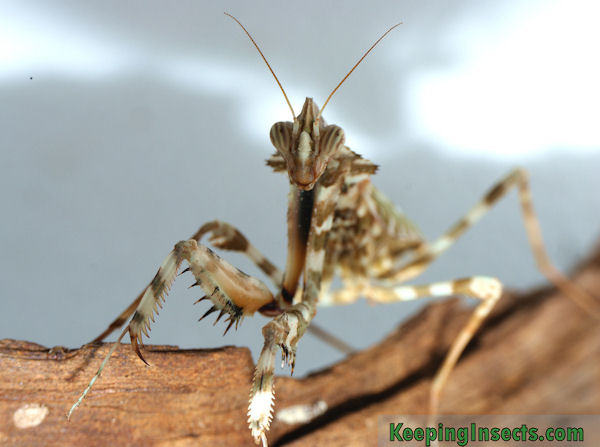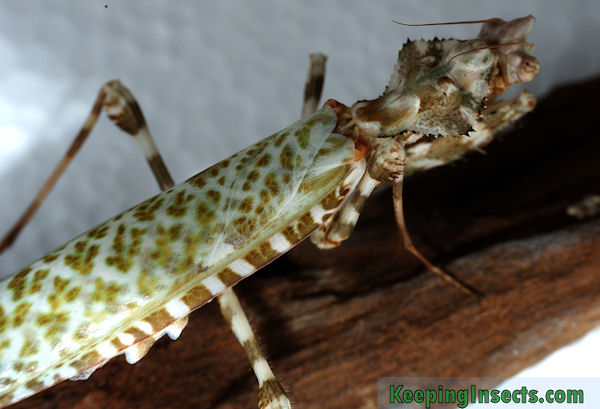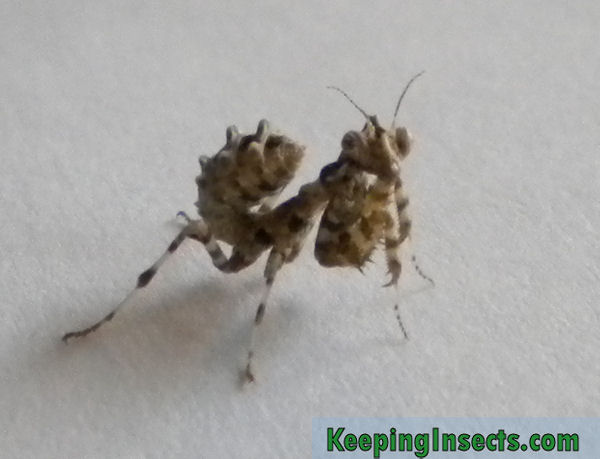The Thistle Mantis, or more specifically Blepharopsis mendica is a beautiful species of praying mantis from North Africa and the Canary Islands. This species is sometimes also called Small Devil’s Flower Mantis, but this could be confused with Devils Flower Mantis (Idolomantis diabolica) so should not be used.

An adult Thistle Mantis – Blepharopsis mendica
Appearance
This species of praying mantis is creamy-white to beige with light green stripes and light green “veins” on the wings as adults. On its back this mantis has a small pointed shield under which the forearms are being kept. The inside of the front legs are orange and blue white white spots. These colors are shown in the threatening posture to deter predators. Blepharopsis mendica will grow to a size of about 5 to 6 cm, with little difference in size between the sexes. The males are more slender with wings that reach a little bit over the end of the abdomen. The females are bulkier with a wider prothorax and with wings that extend to just the end of the abdomen. The females have thin antennae while adult males have feathered antennae (antennae with large thick “hairs” on it).

An adult Thistle Mantis – Blepharopsis mendica. This wing pattern is characteristic for this species.
Behavior of the Thistle Mantis
Blepharopsis mendica is a quiet species of praying mantis. They are good at catching flying insects. Relying on its camouflage it waits patiently until an unsuspecting prey comes along. This species is not very aggressive and can be intimidate by large prey. Blepharopsis mendica can show a deimatic display in which it will raise its wings and hold its forearms in a sideways way. In this posture the mantis looks very big and the bright colors on the inside of the forearms is visible. This is meant to scare away predators.

An adult Thistle Mantis showing its deimatic display, meant to scare away predators
Food for B. mendica
Blepharopsis mendica mainly eats flying insects in nature. Its raptory arms are especially designed to catch flying insects. In captivity it is also advised to only feed flying insects like moths and flies. This species can be fed exclusively on flies (e.g. soldierflies, blue bottle, blowflies). Some breeders say that feeding crickets to B. mendica is bad for their fertility and health.

An adult Thistle Mantis female – Blepharopsis mendica
Environmental conditions
The ideal temperature is about 34 ° C, but can vary between 30 ° C and 40 ° C. If you keep them at a cooler temperature they will not die immediately, but their growth and survival rate is reduced a lot. At night you have to keep the temperature at at least 21 °C.
The Thistle Mantis does not require high humidity but should rather be kept very dry. It needs approximately 30 to 40% humidity. You do have to spray with a little bit of water once a week to give them the opportunity to drink.
As with all species of praying mantis, the enclosure of this species needs to be at least 3 times the length of the animal in height, and at least 2x the length of the animal in width. For an adult this means is at least 18 cm in height and 12 cm in width. A nice size for a terrarium would be 30 x 20 x 30 cm, so there is room for lots of fake plants and perches. Dead leaves are a nice decoration in the enclosure of this mantis. This species is unable to walk on glass or plastic! The tank should have at least one side covered in cork or a rough surface to allow it to walk up in the tank.
Group housing Blepharopsis mendica mantids
The Thistle Mantis Blepharopsis mendica is not an extremely cannibalistic species, but will certainly hunt and eat its own kind if they do not find enough other food. It is therefore not advisable to house nymphs over L4 (fourth instar) together in one enclosure. The risk of cannibalism is very small, but with these predators will it always exist.

An young Thistle Mantis nymph
Breeding the Thistle Mantis
This species can be hard to breed. If you manage to get this species to healthy adulthood, you can try mating them.
The females of this species are slightly larger and broader than males. When the mantids are nymphs this difference can be seen better with every molt. Also the antennae reveal the sex of the mantis. The antennae of the male are longer and much thicker than that of the female. You can also try the Segment Counting Method.
Approximately 2 to 4 weeks after the final molt, a mating attempt could be made. Make sure the female has eaten very well before you put the male with her. Usually the female is not too agressive, but it is certainly possible that she will attack the male. Mating can take several hours. If mating fails to produce fertilized eggs, it can help to keep the mantises at very high temperatures (35-40 degrees) a few days prior to mating. Especially the male can benefit from this.
Side note
This species is harder to keep than most species, because of the special high temperatures. Therefore, this species is not recommended for the beginner. A more experienced or dedicated insect keeper would find an amazing species in the Thistle Mantis.
